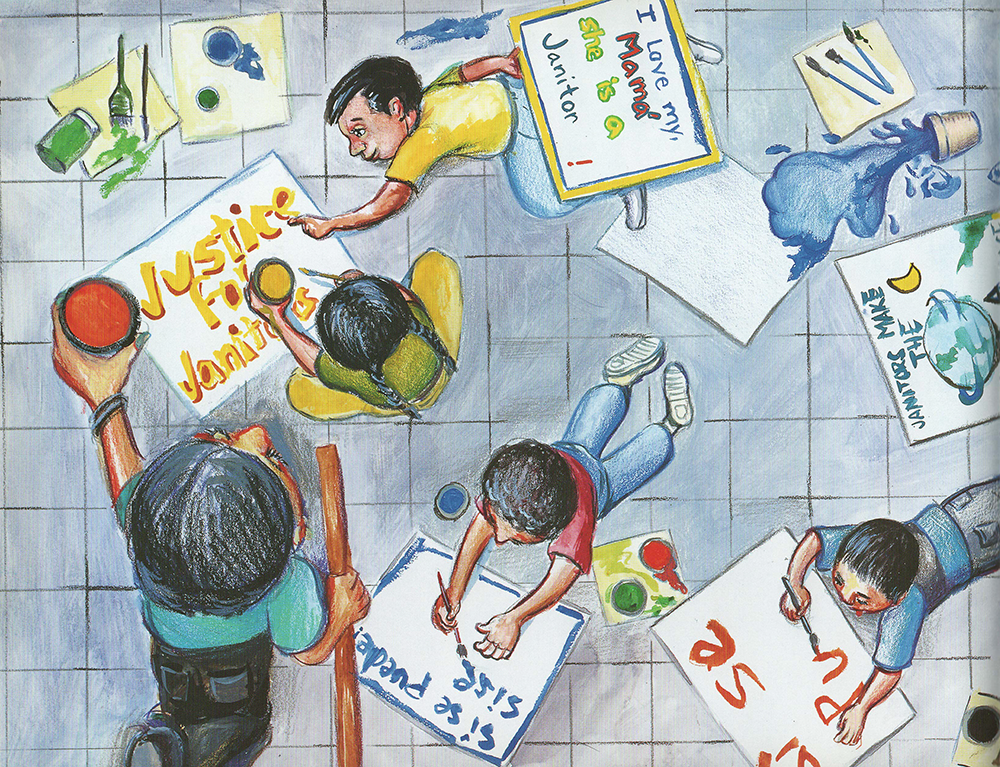¡Sí, Se Puede! Yes, We Can!
Lesson by Marcy Fink Campos
As a parent of a 2nd- and a 4th-grader, I am always looking for books that discuss social justice issues in ways that children can understand. In October 2002 I had the good fortune to discover the book ¡Sí, Se Puede! Yes, We Can!: Janitor Strike in L.A. through a bilingual librarian friend. This book addresses issues such as low-paying jobs, long work hours, and organizing for change, and puts a human face on them. Explaining the purpose of a union is abstract; this book succeeds in demystifying unions by giving specific examples of what a particular union does.
That the book is bilingual makes it all the more rich and accessible. It connects concretely with real people’s lives in their language of origin. Many janitors in urban areas today are from Spanish-speaking countries. Some have left these countries to seek a better life for themselves and their children, just as Carlitos’ mother did. ¡Sí, Se Puede! Yes, We Can! honors both a mother’s commitment to her family and the work of janitors. All the parts of the book— the story itself, the inside cover with its history of unions and strikes, the essay on Dolores Sanchez by writer Luis J. Rodriguez — contribute to the educational experience as a whole.
I developed a short lesson to accompany the reading of this book and took it to a fourth-grade dual-language class where the students are taught for half of the day in Spanish and half of the day in English. Although I anticipated that some of the new vocabulary and concepts would be a stumbling block to comprehension, I was pleased to find how easily the kids connected with Carlitos’ story. These nine-year-olds could understand the injustice of the amount of time his mother had to work hard to help her family survive and the low pay she received.
©2002 Cinco Puntos Press. Illustration by Francisco Delgado.
Objectives
Students will be able to:
identify what a union does and why a strike takes place;
use vocabulary the teacher picks from the lists that follow or from the story;
explain how Carlitos’s mother became a leader both in her union and in Los Angeles;
name at least three things that workers can change if they win a strike;
name at least three things that can get worse if workers lose a strike;
use the words who, what, when, why, how, or where in questions; and
make up five questions they might ask a custodian, cafeteria worker, secretary, or other staff person in their school.
Materials
¡Sí, Se Puede! Yes, We Can!: Janitor Strike in L.A., by Diana Cohn; translated by Sharon Franco; illustrated by Francisco Delgado; with an essay by Luis J. Rodríguez, published by Cinco Puntos Press, 2002
Vocabulary terms on index cards in a paper bag
Copies of the two-page essay on Dolores Sanchez found at the back of the book
Flipchart or handout listing questions; two to four questions per sheet and one sheet per group
Markers (two per group)
Masking tape
Vocabulary
© Cinco Puntos Press. Illustration by Francisco Delgado.
Before reading the story to the children, write the vocabulary words below on index cards and place the cards in a paper bag. They will be used during the story. Later, the cards can be used for reviewing meanings and spelling, for writing sentences, etc.
(English version)
strike – huelga
rally – mitín
farmworkers – trabajadores agrícolas
union – sindicato
marched – manifestaron
janitor – trabajador de limpieza
pay raises – aumento de sueldo
popsicle – paleta
pastry/donut – churro
grandma – abuelita
‘yes, we can;’ or ‘yes, it can be done’ – sí, se puede
may you sleep with the angels – que sueñes con los angelitos
(Spanish version)
aceras – sidewalks
friega los azuelejos – scrubs the tiles
merecer – deserve
dar brillos a los pisos – polish the floors
deslizarte – slide
parada de autobus – bus stop
vacias – empty
Pre-Reading
Show the book to students and pose the following questions:
Does the cover give you any idea of what this book might be about?
Who is the author?
Who is the illustrator?
What does the title tell you?
What jobs need to get done to keep schools and workplaces clean?
Does keeping them clean make a difference?
In this school, who does these jobs?
What are their names and titles?
Tell students that this story is fiction, but that it is based on a real person named Dolores Sanchez and other members of SEIU Local 1877, whom the author, Diana Cohn, got to know. The year in which all this happened was 2000. Dolores is 37 years old, and she is originally from Mexico. She works nights cleaning a building in Los Angeles. Show them her picture in the Luis J. Rodríguez essay at the back of the book.
Reading the Story
Have some of the children pull a card from the vocabulary bag and say the word they will be listening for as you read. When a vocabulary word appears in the story, the student with the card for that term can tell the class what it is and post the word on the wall, chalkboard, or flip-chart pad. Read the story aloud. If needed, use questions for clarification as you go along. Conclude the reading by asking: What does Carlitos’ mother do that shows her love for him? What does he do to show his appreciation and love for her?
Follow-up Questions and Activities
Facts and Figures
How many janitors went on strike in all? 8,000
How long did it take to win the strike? How long did people stay out of work before they gained what they wanted? 3 weeks
Their pay before the strike was $7 per hour; their pay after the strike was about $9.50 per hour, plus benefits. Can people live on this amount of pay? How might you find out?
If you worked an eight-hour day, how much would you earn in one day at $7.00 per hour? (Students can do the multiplication in pairs.) $56
In one week? (40 hours) ($7.00 x 8 hours/day x 5 days or $7.00 x 40 hours) $280
In 4 weeks? (4 x 280) $1,120
In one year? (52 weeks) $14,560
Compare this yearly salary to salaries of people in other jobs. Students might use newspaper “help wanted” ads to find out what salaries are, or you can give them some examples.
Small-Group Discussions
Form small groups (Groups A, B, C, D). Write two questions on a flipchart or on pieces of paper. Groups will write answers in complete sentences on the flipchart or paper. Give the groups ten to 15 minutes to discuss, answer, and write their responses to the questions on the flipchart or paper and post their answer sheets on the wall. Have students take turns answering them orally, with one spokesperson per group.
Adapt this activity according to the needs of your group. Students might answer all the questions instead of two, do other questions you develop, or answer some in English and some in Spanish.
Questions in English
Group A
1. When does Carlitos’ mother work and when does she sleep? Why?
2. In addition to her work as a janitor, what other jobs does she do?
Group B
3. Why did the janitors decide to go on strike?
4. Use your own words to say what a strike means.
Group C
5. Why was Carlitos’ mother on the television news?
6. How does Carlitos feel about his mother being on strike?
Group D
7. What did Carlitos’ class do to help the strikers? Who else helped them?
8. Did the janitors win their strike? What changed for Carlitos’ mother once it was over?
Preguntas en Español
Grupo A
1. ¿Cuándo trabaja la mamá de Carlitos y cuándo duerme? ¿Por qué?
2. Además de trabajar como trabajador de limpieza, ¿qué otro trabajo hace la mamá de Carlitos?
Grupo B
3. ¿Por qué decidieron los trabajadores irse a una huelga?
4. ¿Qué significa “huelga”?
Grupo C
5. ¿Por qué salió la mamá de Carlitos en las noticias en la televisión?
6. ¿Cómo se siente Carlitos que su mamá está en huelga?
Grupo D
7. ¿Qué hizo la clase de Carlitos para apoyar a su mamá? ¿Quíén más ayudó a ellos?
8. ¿Ganaron los trabajadores su huelga? ¿Qué cambió para la mamá después de la huelga?
Interviews with School Workers
Ask students to identify the different people who work in their school and list them on the board or on a flipchart (for example: school principal, assistant principal, librarian, cafeteria workers, playground aides, teachers, secretaries, counselors). Explain that in order to find out more about these people’s jobs, small groups of students will interview them. Review the meaning of the word interview with the students. Each group will develop a set of interview questions. List and review words often used in beginning a question: who, what, why, when, where, how.
Form groups of three to four students, and ask each group to choose a different worker to interview. Then, have each group think of five questions they might ask that individual. Ask them to write their questions on chart paper. Write directions on the board or flip chart as well, specifying the amount of time they have for this assignment. (This group work should take about 15 minutes.)
Have one person from each group read the group’s questions aloud to the other students to get feedback.
The teacher should review the questions, correct them, and modify them, if necessary. For the next class, students can rewrite the questions either by hand or on a computer.
Have students practice the interview. Each person in the group should practice a different role: interviewer, note taker, and writer of final copy. Students and teacher can give feedback on the techniques used in the roleplaying.
Next, each group arranges the actual interview with its staff person and completes the interview.
Set up a time when each group can make their presentation to others in the class.
Synthesize what the class has learned about the various roles.
© 2003 Marcy Fink Campos



